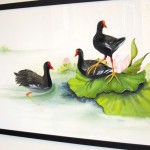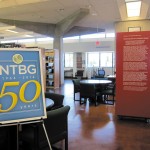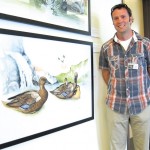A Focus On Native Bird Species
NTBG opens an art exhibit featuring paintings by Marian Berger in the classic style of John James Audubon
Visually captivating watercolors of rare, native birds are currently on display at National Tropical Botanical Garden’s headquarters in Kalaheo. The pieces were created by wildlife artist Marian Berger, who completed them in 2011 in the style of John James Audubon. This is the first time on Kauai these images are being presented to the public.
- Berger’s painting of the critically endangered akikiki (Kauai honey creeper) | Photo courtesy of Marian Berger
- The alae ula (Kauai moorhen) painted by Berger and currently on display at NTBG headquarters in Kalaheo
There are 34 total paintings representing 37 living (more than half of the known species of birds in Hawaii are extinct) species or sub-species of Hawaiian birds found nowhere else in the world. The endemic fauna include forest birds such as the akikiki, water birds such as the alae ula and raptors such as the pueo. Some of the represented birds have population numbers that are dangerously low, including the alala (Hawaiian crow), which is extinct in the wild and currently breeds only in captivity. A few of the species suffer imminent extinction within the next five to 10 years if habitat destruction and introduced species — goats and rats — are not mitigated.
“There’s this whole ecological system that’s dependent on these species for survival,” says John Clark, co-director of science and conservation for NTBG and curator of the exhibit. “When one of those pieces is missing then the whole thing can ultimately fall apart.”
A large group of plant species are dependent on native birds for pollination, and if they don’t have them they too are vulnerable to extinction.
Each of the paintings include a representation of one or two plant species that pair with the birds — serving as their habitat or food source. Some of the scientific specimens of the plants are even included in display cases along with the paintings.
“It ends up being excellent talking points,” says Clark.
- NTBG is holding an art exhibit featuring 37 species and sub-species of living endemic Hawaiian birds
- John Clark, curator of the new art exhibit at NTBG headquarters in Kalaheo. Coco Zickos photo
The paintings are located in NTBG’s Botanical Research Center, a LEED gold-certified building where plant species are collected and stored. The herbarium is where species of all varieties, native and invasive, are preserved and kept according to where and when they were discovered, allowing scientists to understand how plants on the island have evolved over an extended period of time.
“The more we know about the good, the bad and the ugly, we can use that to do what’s a major part of our mission, which is conservation research,” says Clark.
Also located in the building is a seed bank and a research library, and plans are underway to develop a molecular facility to further increase knowledge of plant DNA.
The exhibit is another way NTBG is enticing people to learn more about its mission to help perpetuate and preserve native flora. The nonprofit is celebrating its 50th anniversary this year and has been offering a number of activities that encourage people to visit its scientific research center. The previous exhibit consisted of a collection of artwork from Capt. James Cook’s first voyage of discovery.
“Everyone has some kind of appreciation or fascination with art,” says Clark.
The artwork brings people through the doors and allows them to also appreciate other, possibly less-enticing subjects like botany and conservation.
“The more people who know about what we do, the more support we receive and the better off we are in the long run,” says Clark.
“The Living Endemic Birds of Hawaii” is open from 10 a.m. to 4 p.m., Monday through Friday until Aug. 29 at 3530 Papalina Road in Kalaheo. Visit ntbg.org/art for more information.
cocomidweek@gmail.com







